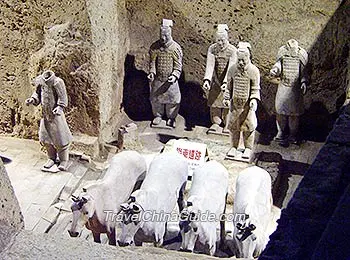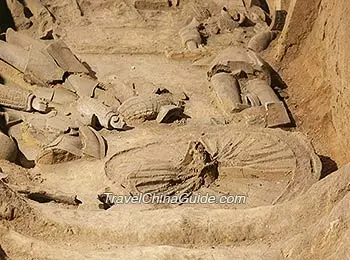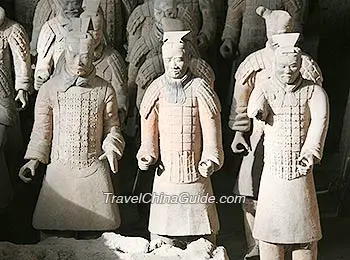Chariot warriors are those fighting on or around the chariots during battle. Each chariot is equipped with different numbers of warriors. Terracotta Chariot Warriors have been discovered in all three pits where the
Terracotta Army have been uncovered.
Chariot
It is estimated that the total number of chariots inside the three pits of the Terracotta Army is about 140. More than 50 are believed to be buried in
Pit 1, 89 in
Pit 2 and one in
Pit 3. All of the discovered chariots use wooden material, with single shaft, double wheels, and three or four lifelike pulling horses standing in front of the chariot. The chariots discovered in the pits are sorted into four types: common chariots, command chariots, assistant chariots and superior chariots. They all have the same shape and structure, but the decorations and functions vary. Of the chariots unearthed so far, only a few have been superior chariots. A small number of command and assistant chariots have been found, but most chariots are of the common type.
 | | Chariot Warriors | |  | | Chariot Relics | |
Chariot Warriors on Common Chariots
 |
| Warriors on Common Chariot |
There are usually three terracotta chariot warriors figures on common chariots: the principal charioteer, the left-hand charioteer and the right-hand charioteer. As the name implies, the principal charioteer stands between the left-hand and right-hand charioteer figures. With raised arms, the charioteer controls the horse’s reins from the middle of chariot. Dressing uniformly, the left-hand charioteer figure and right-hand charioteer figure have the opposite postures holding long weapons in one hand, while holding on to the chariot with the other. In addition, the archaeologists find a lot of bronze arrows nearby, so it is clear that the arrows were used as weapons at that time.
All three types of terracotta chariot figures on common chariots have a clear division of responsibility. The charioteer figures are very important for their vital driving ability and particular position. They are 1.89 meters (6.20 feet) in height, wearing crowns and long gowns covered by armors. The armor is especially elaborate and rarely seen among the excavated warriors, for it covers their entire arms. There is protective armor on the hands and neck, too. At 1.82 meters (5.97 feet) tall, the left-hand and right-hand charioteer figures are responsible for fighting against enemies from both sides of the chariot. They wear long robes and armors as well. Their heads are turned a little to the chariot driver as if to carefully listen to the commander’s orders and prepare for combat.
How to Select Chariot Warriors
A well qualified chariot warrior was select according to strict requirements and standards. According to historical records, the soldiers needed to be under 40 years and taller than 1.73 meters (5.68 feet) with a strong body, and had to be fast runners to catch up with the horses. The chariot warriors not only had to be good at fighting on the chariots but also had to be versatile enough to fight with enemies on foot around the chariots.
Chariot Warriors on Command, Assistant and Superior Chariots
On the command chariots, you can see the chief commander, the horseman and a versatile warrior. The commander was in charge of pounding the war drums and gongs to guide the fighting.
The assistant chariot follows the commanding chariot into battle. The two figures on it could be the substitutes for the horsemen and versatile warriors on the front chariots.
Four terracotta chariot warriors stand on the superior chariot, with one general figure wearing colorful lacing armors, long crowns and three figures wearing ordinary armors and short crowns.
- Last updated on Aug. 04, 2025 by Alex Jin -


